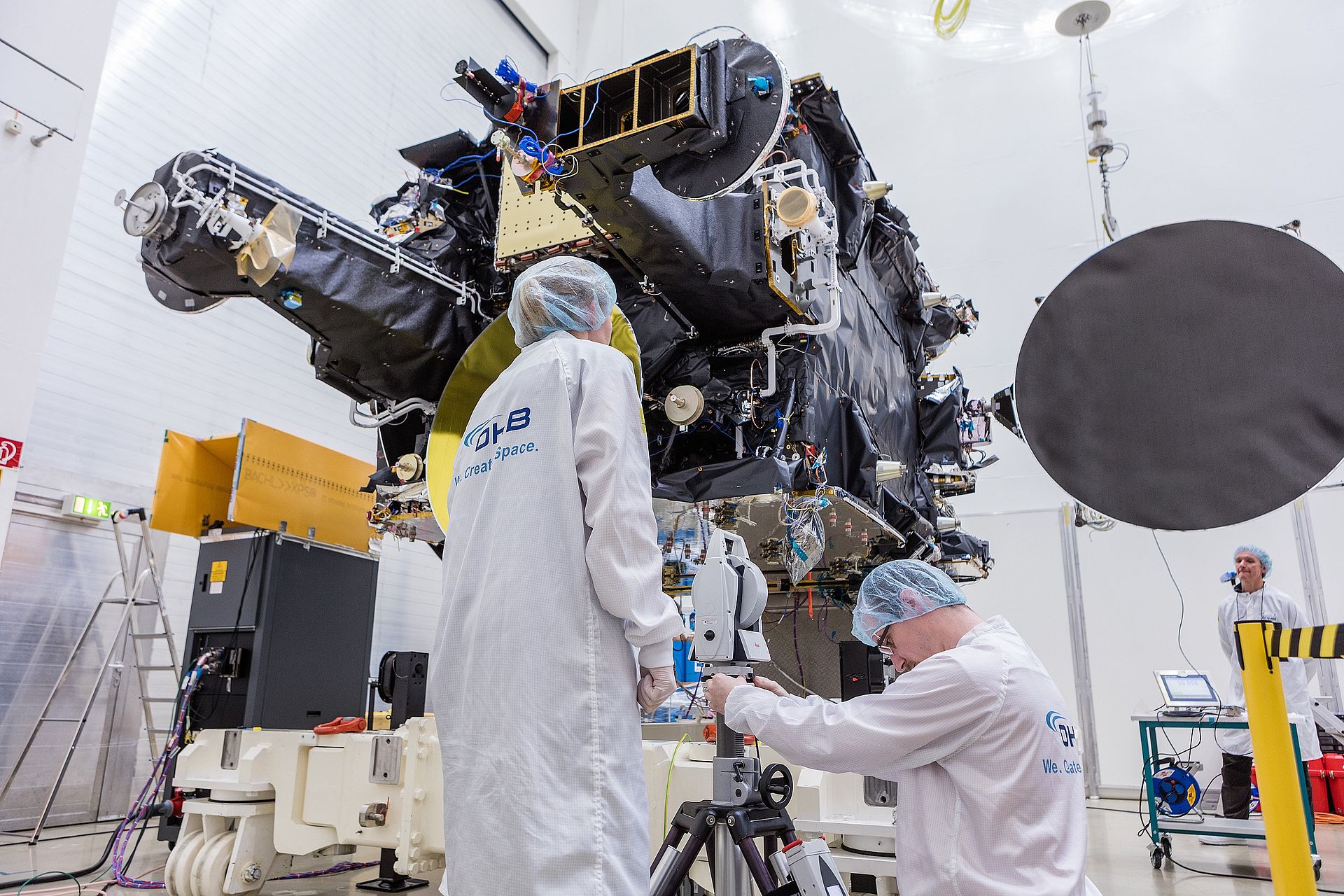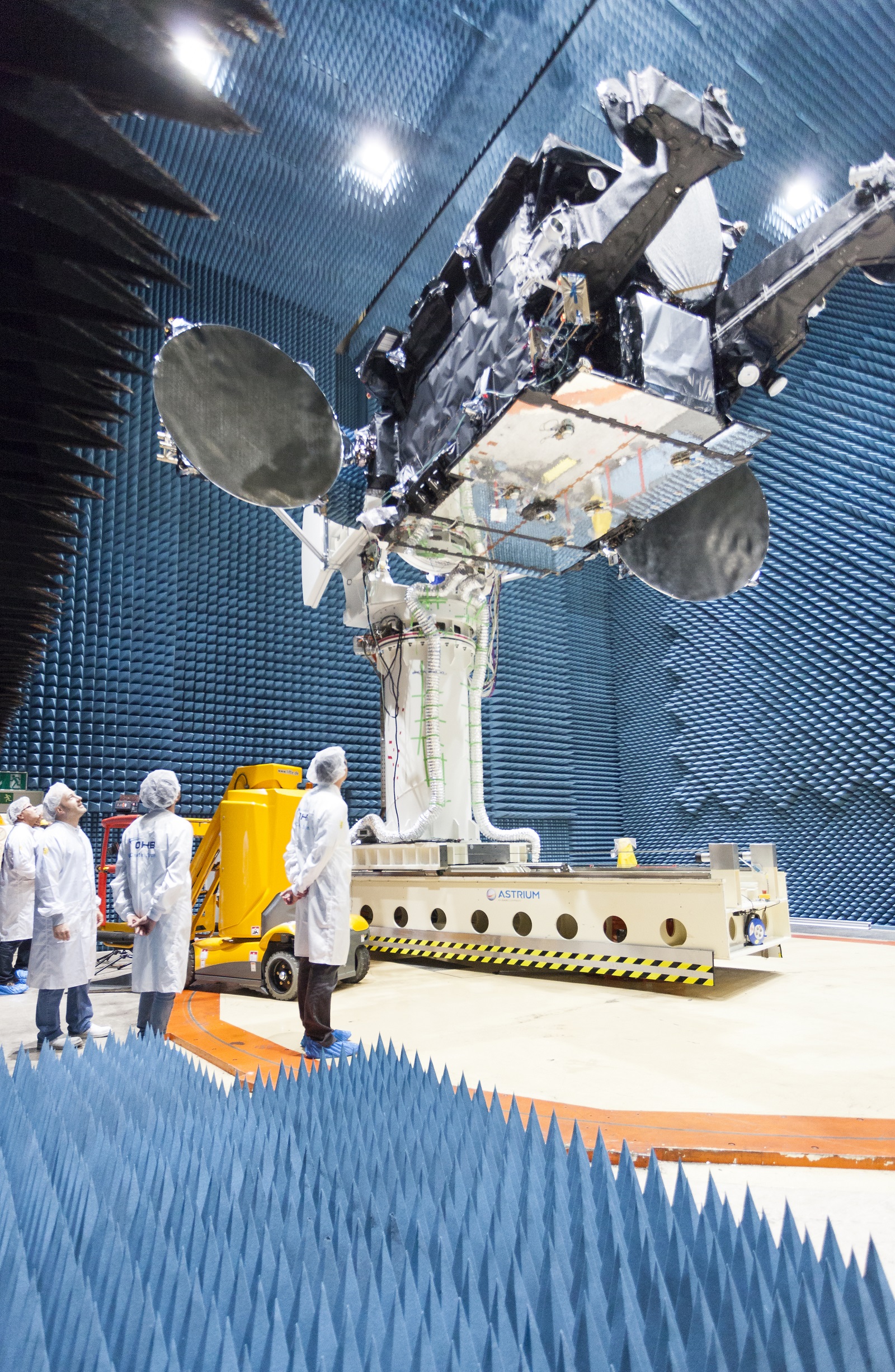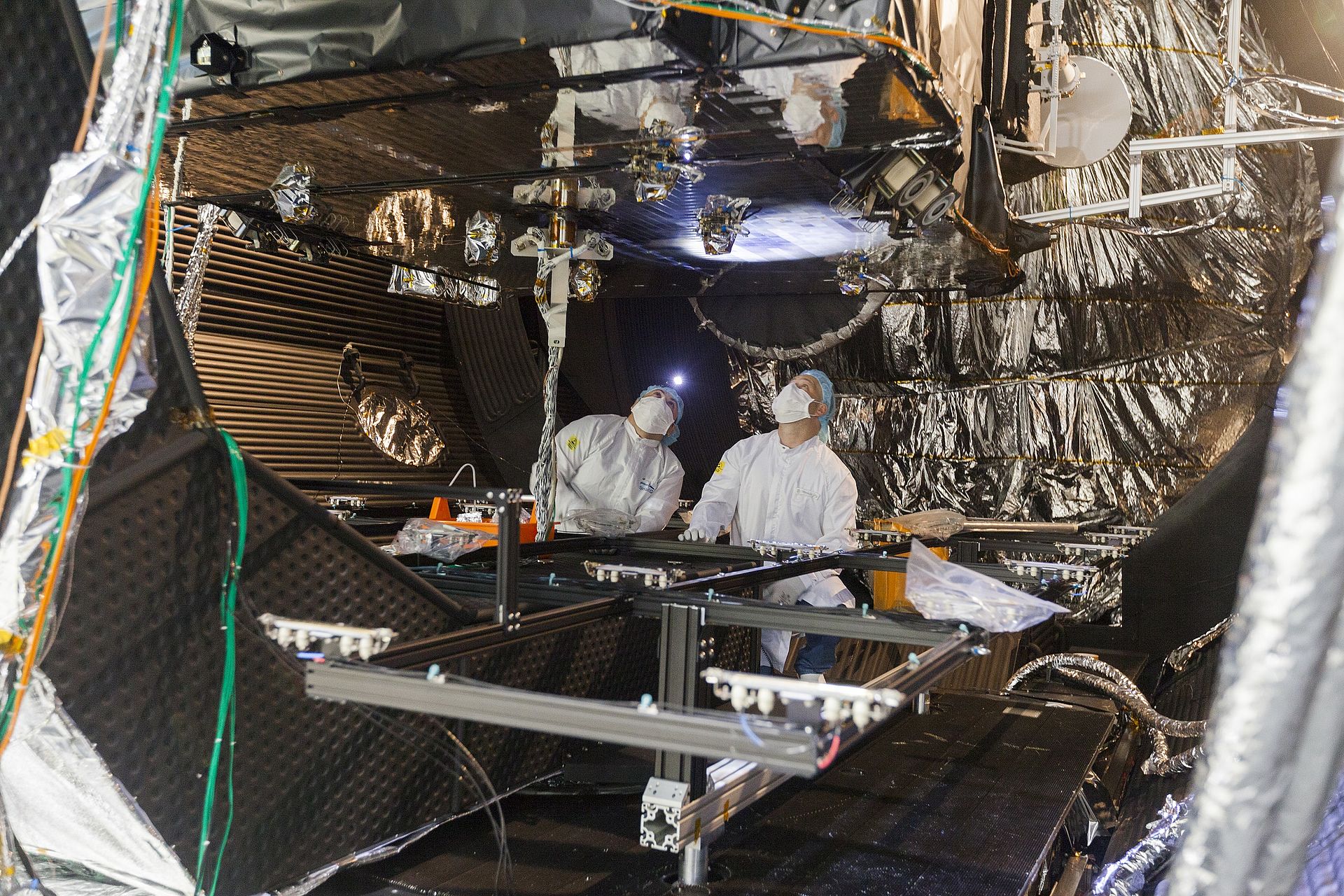Bremen/Kourou, January 28, 2017. In the early hours of the morning, the telecommunications satellite H36W-1 produced by space technology company OHB System AG reached its target orbit at an altitude of 36,000 kilometers. A Russian Soyuz carrier had lifted off on schedule at 2.03 hours CET from Europe’s Spaceport in Kourou, French-Guyana. Roughly half an hour later, the carrier released the satellite with a mass of 3,200 kg into its geostationary transfer orbit.
The successful launch of the first satellite from the SmallGEO range marks a milestone in OHB’s history. SmallGEO is the first telecommunications satellite to be developed, integrated and tested in Germany for more than 20 years.
“We are thrilled and relieved that H36W-1 is now on its way. The first satellite is always a major step particularly in the case of a new specially developed platform in such an important segment as the telecommunications market. We have developed, managed and implemented an integrated design, which we have tested intensively during an eleven-month test campaign. We are very confident of achieving good performance from the end of March,” says Dr. Dieter Birreck, the responsible project manager at OHB System AG.
The German Aerospace Center (DLR) satellite control center received the first “sign of life” from the satellite just under one hour later via the ground centers in Kumsan, South Korea, and Uralla, Australia. 22 employees from OHB System AG, four from OHB Sweden and two from OHB Italia are working around the clock at the satellite control center to ensure the smooth start-up of the telecommunications satellite and to support mission control. H36W-1 will be reaching its geostationary test position in twelve days’ time, where it will be calibrated and placed in operation over a period of a good five weeks. After a voyage of a further nine days, the satellite will reach its final position over 36 degrees longitude west, where it will provide communications services for Europe, the Canary Islands and South America for Spanish operator HISPASAT over a period of more than 15 years.
The first of its kind
Germany’s return to system capability in the commercial market for telecommunications satellites has its roots in the close partnership between OHB System AG, the German Aerospace Center (DLR), the German Federal Ministry of Economics and Technology (BMWi) and the European Space Agency (ESA). The development of SmallGEO is expressly included in the German space strategy and underscores the country’s wish to act independently and flexibly in the small satellite segment.
Developed by OHB System AG as part of the ESA ARTES program (Advanced Research in Telecommunications Systems), SmallGEO is a flexible geostationary satellite platform which can be tailored for different mission goals such as telecommunications, Earth observation and technology testing. With its modular structure, the SmallGEO satellite platform can be modified flexibly to meet specific customer requirements. Customers can select a classic, hybrid or electric propulsion system for the satellite. Depending on the type, it has a launch mass of between 2,500 and 3,500 kg, with a permitted payload mass of between 450 and 900 kg. Measuring 3.7 x 1.9 x 2 meters, H36W-1 had a launch mass of 3,200 kg.
Involvement of further OHB SE companies
In addition to OHB System AG acting as the prime contractor, three of OHB’s European sister companies were also involved in the successful development and realization of this first SmallGEO satellite and will also contribute to future SmallGEO platforms. OHB Sweden delivered innovative subsystems for electric propulsion and attitude and orbit control. Luxspace delivered the telemetry, telecontrol and ranging subsystem and actively participated in its validation at the satellite level. In addition, LuxSpace contributed to the development of the satellite simulator. OHB Italia developed the payload management unit and supported system engineering of the thermal control subsystem.
Further OHB SmallGEO projects
The first SmallGEO satellite, the H36W-1, was completed in the form of a private-public partnership between ESA, OHB and the Spanish satellite operator HISPASAT. Further projects in the conventional telecommunications segment include EDRS-C (laser relay) and Heinrich Hertz (in-orbit verification of numerous national scientific and technical innovations as well as satellite communications for the German federal armed forces). OHB is developing Electra, a satellite with a fully electric propulsion system based on the SmallGEO platform, which will be able to carry a substantially larger payload due to the lighter weight of the propulsion system. Europe’s future fleet of weather satellites, the “Meteosat Third Generation” EUMETSAT satellites, is also based on the SmallGEO satellite platform.
About OHB System AG
OHB System AG is one of the three leading space companies in Europe. It belongs to listed high-tech group OHB SE (ISIN: DE0005936124, Prime Standard), where around 2,200 specialists and system engineers work on key European space programs. With two strong sites in Bremen and Oberpfaffenhofen near Munich and 35 years of experience, OHB System AG specializes in high-tech solutions for space. These include low-orbiting and geostationary satellites for Earth observation, navigation, telecommunication, science and space exploration as well as systems for human space flight, aerial reconnaissance and process control systems.
About HISPASAT Group
HISPASAT Group is comprised of companies that have a presence in Spain as well as in Latin America, where its Brazilian affiliate HISPAMAR is based. The Group is a world leader in the distribution and broadcasting of Spanish and Portuguese content, and its satellite fleet is used by important direct-to-home television (DTH) and high-definition television (HDTV) digital platforms. HISPASAT also provides satellite broadband services and other added value solutions to governments, corporations and telecommunication operators in America, Europe and North Africa. HISPASAT is one of the world's largest companies in its sector in terms of revenue, and the main communications bridge between Europe and the Americas.
About the European Space Agency
The European Space Agency (ESA) provides Europe's gateway to space.
ESA is an intergovernmental organisation, created in 1975, with the mission to shape the development of Europe's space capability and ensure that investment in space delivers benefits to the citizens of Europe and the world.
ESA has 22 Member States: Austria, Belgium, the Czech Republic, Denmark, Estonia, Finland, France, Germany, Greece, Hungary, Ireland, Italy, Luxembourg, the Netherlands, Norway, Poland, Portugal, Romania, Spain, Sweden, Switzerland and the United Kingdom. Slovenia is an Associate Member.
ESA has established formal cooperation with six Member States of the EU. Canada takes part in some ESA programmes under a Cooperation Agreement.
By coordinating the financial and intellectual resources of its members, ESA can undertake programmes and activities far beyond the scope of any single European country. It is working in particular with the EU on implementing the Galileo and Copernicus programmes as well as with EUMETSAT for the development of meteorological missions.
ESA develops the launchers, spacecraft and ground facilities needed to keep Europe at the forefront of global space activities.
Today, it develops and launches satellites for Earth observation, navigation, telecommunications and astronomy, sends probes to the far reaches of the Solar System and cooperates in the human exploration of space. ESA also has a strong applications programme developing services in the Earth observation, navigation and telecommunications domain.
Contact for media representatives:
Marianne Radel
Head of Corporate Communications
Phone: +49 421 2020 9159
Email: marianne.radel@ohb.de
Contact for investors and analysts:
Marcel Dietz
Investor Relations
Phone: +49 421 2020 6426
Email: ir@ohb.de



